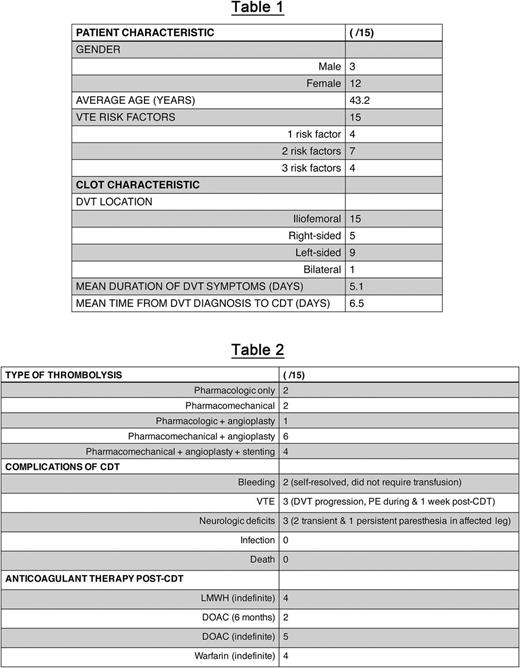Abstract
BACKGROUND
Conventional management strategies for DVT with parenteral and/or oral anticoagulants are effective in the prevention of thrombus extension and embolization but do not actively eliminate thrombus. This poses ongoing risk of injury to the venous valves and consequently development of the post-thrombotic syndrome (PTS). Catheter-directed thrombolysis (CDT) involves the local delivery of a low dose of thrombolytic agent directly to the venous thrombus, resulting in acute reduction in clot burden while limiting the systemic thrombolytic effect.
Recommendations from clinical practice guidelines differ dramatically on the use of CDT for lower limb DVTs. Results from recent prospective randomized control trials suggest that those individuals who derive benefit must be carefully selected. We describe the clinical features and outcomes of patients who received CDT for lower limb DVT management at a major referral centre for thromboembolic disease. Additionally, cross-sectional follow-up of these patients was performed to estimate the incidence and severity of PTS.
METHODS
We conducted a retrospective cohort analysis on all adult patients who had undergone CDT for lower limb DVT management at St. Joseph's Healthcare Hamilton (SJHH), ON, Canada. Retrospective data were collected through use of electronic and chart-based medical records. The presence and severity of PTS was measured using the Villalta scale.
RESULTS
From 2011 to 2016, 15 patients underwent CDT at SJHH (Table 1).12/15 patients were female. Average patient age was 43.2 years (range 20 to 86 years). All patients had risk factors for venous thromboembolism (VTE); 7/15 patients had 2 risk factors. The most commonly identified transient risk factor was use of the oral contraception pill (5/15). May Thurner syndrome (5/15) was the most common permanent VTE risk factor. All patients were deemed to be at low risk of bleeding (platelets > 100,000, INR < 1.6, no known bleeding diathesis).
All patients had DVTs that were iliofemoral in location; 2/15 presented with phlegmasia cerulea dolens. The average time between DVT diagnosis to CDT was 6.5 days. Prophylactic IVC filters were inserted prior to CDT in 3/15 patients. Pharmacomechanical thrombolysis with angioplasty was the most common form of CDT (6/15 patients).
Complications from CDT were seen in 8/15 patients (Table 2). Recurrent VTE (3/15) and neurologic deficits in the affected leg (3/15) were the most common complications. There were no deaths attributable to CDT. All patients were managed with anticoagulant therapy post-procedure. The type and duration of anticoagulation was variable (Table 2). The Villalta score was calculated for 6/15 patients. Mild PTS was seen in 4/6 patients; 2/6 did not have PTS (average Villalta score 5.83).
CONCLUSIONS
Catheter-directed thrombolysis appears to be a well-tolerated treatment option for iliofemoral DVT. Complications were seen in 53% of patients and were frequently mild and self-resolving. The results of our study suggest that patients under 45 years of age who receive prompt thrombolysis, within 7-14 days of DVT diagnosis, are most likely to derive benefit from CDT. The clinical characteristics of patients described here are largely in accordance with those recommended by the 2016 CHEST guidelines.
Due to the limited sample size in our study, it is unclear if CDT is beneficial in reducing rates of PTS. Additional studies are needed to clarify potential risks and benefits of this treatment approach.
No relevant conflicts of interest to declare.
Author notes
Asterisk with author names denotes non-ASH members.


